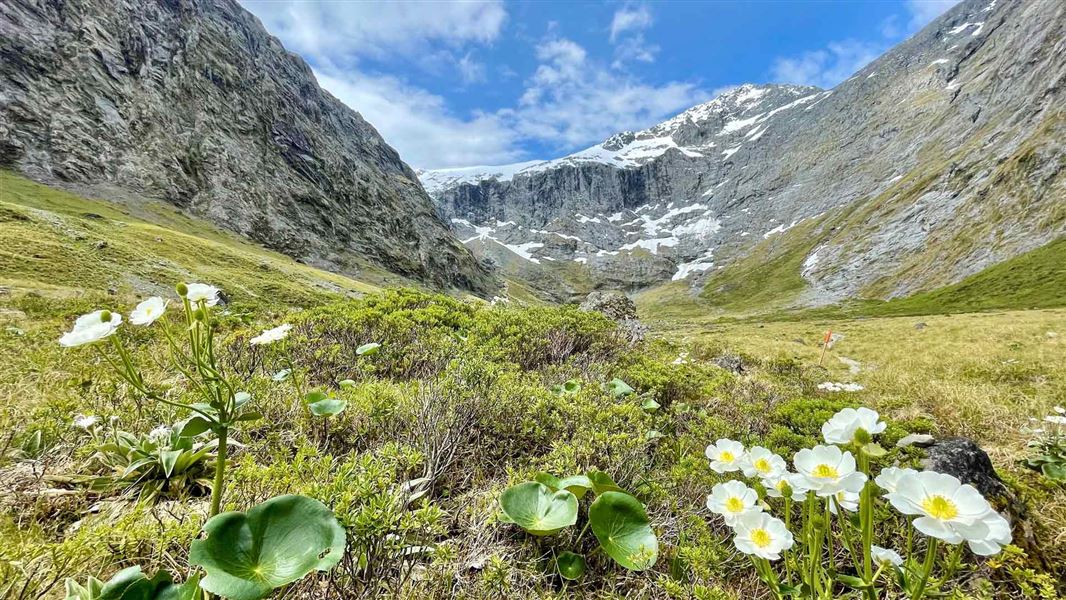Image gallery
Video

Steep climbs on Gertrude Saddle Route
This is a challenging tramping route requiring tramping and alpine experience, and is not recommended in winter due to avalanche danger.
From the car park, the marked track meanders up the valley through spectacular alpine vegetation. From the head of the valley the route leads up towards the saddle; from this point there are no permanent track markers. Cross the Gertrude Stream below a large, steep waterfall area, about halfway up to Black Lake.
From here, parts of the track are very steep and not suitable for those with limited tramping experience, or a dislike for heights. The track goes up steep rock slabs and is treacherous when wet or frosty - there are steel cables to assist you.
From the head of the valley continue up through the boulders to the saddle. Return the same way.
Breathtaking views of the valley and part of Milford Sound/Piopiotahi can be seen from the Gertrude Saddle. This track provides excellent access to the mountains for experienced climbers.
If there's rain or snow, don't go. You need to cross multiple rivers and steep granite slabs on this route. Check the NIWA weather forecast.
Understand if you are ready for the Gertrude Saddle Route
Watch the NZ Mountain Safety Council’s walk-through video which takes you through how to prepare for this track. Including facilities, key decision points, hazards and typical conditions for the area.
This track is reached from the Gertrude Valley carpark, about 98 km along the Milford Road from Te Anau.
Essential safety
Only attempt this track if:
- you are fit and experienced – on the route you will have to scramble up steep rock, cross rivers, and avoid hazards by following markers
- track and weather conditions are good on the day
- you have the right equipment, including a personal locator beacon – see the Day hikes gear list.
This is an alpine route
There are no permanent markers above the bushline, so alpine and navigation skills are essential. Rock cairns placed by trampers mark the route, but be sure to follow your own judgement and use a topographical map.
This is an alpine route and is subject to avalanches after snow.
Weather
Check the Fiordland National Park weather forecast and talk to the staff at the Fiordland National Park Visitor before you go, whenever you go.
After rain there are some creek crossings so expect to get wet feet.
Avoid wet rocks
Wet moss on the rocks and rock slabs of the route is very slippery. It can be treacherous.
Stay safe when crossing rivers
If you plan to cross unbridged rivers, know how to cross safely and be prepared for if you cannot cross.
Do not cross if the river is flooded, you cannot find safe entry and exit points or are unsure it’s safe. Turn back or wait for the river to drop. If in doubt, stay out.
There may be avalanche danger
Check the avalanche terrain in this area.
Avalanches usually occur from May to November in Fiordland National Park. There can also be avalanches outside this period, if there is still snow coverage.
Check the avalanche danger before you go on the New Zealand Avalanche Advisory.
If you are going into avalanche terrain, always:
- Have the relevant avalanche skills and training.
- Check the ATES rating and the New Zealand Avalanche Advisory.
- Go with a buddy. Both of you should carry and know how to use an avalanche transceiver, a snow shovel and a probe.
Stay safe in the outdoors
- Choose the right trip for you. Learn about the route and make sure you have the skills for it.
- Understand the weather. Check weather forecasts.
- Pack warm clothes and extra food. Check gear lists.
- Share your plans and take ways to get help. Leave your intentions with a trusted contact and take a distress beacon.
- Take care of yourself and each other.
Te Rua-o-te-moko/Fiordland National Park Visitor Centre
| Phone: | +64 3 249 7924 |
| Email: | fiordlandvc@doc.govt.nz |
| Address: | 1 Lakefront Drive Te Anau 9600 |
| Hours: | Visitor centre hours and services |
